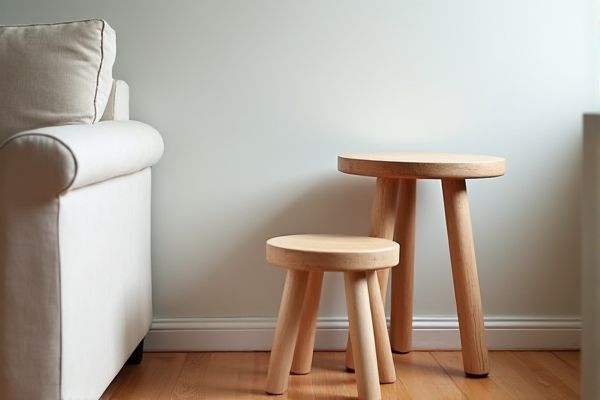
Stacking stools are designed to be piled vertically to save space efficiently, making them ideal for environments with limited floor area, while nesting stools slide neatly beneath each other for compact storage without the need to stack. Understanding the functional differences helps you choose the best option for your space and usage needs--read on to explore which stool style suits your lifestyle.
Table of Comparison
| Feature | Stacking Stool | Nesting Stool |
|---|---|---|
| Design | Identical stools stacked vertically | Varied sizes fit one under another |
| Space Efficiency | Compact vertical storage, saves floor space | Compact horizontal storage, saves more space |
| Usage | Quick access, easy to store multiple stools | Flexible use with varied heights and sizes |
| Portability | Lightweight, easy to carry in stacks | Moderate weight, individual stools portable |
| Material | Commonly plastic, metal, or wood | Often wood or metal, designed for nesting |
| Cost | Typically economical | Varies; generally higher due to design |
| Durability | Durable but may wear at contact points | Durable with protection for nested surfaces |
Introduction to Stacking Stools and Nesting Stools
Stacking stools are designed for efficient storage by allowing multiple stools to be securely placed one on top of another, making them ideal for space-saving in both commercial and residential settings. Nesting stools, on the other hand, slide or fit neatly under each other in varying sizes, offering a versatile solution for compact storage and flexible seating arrangements. Both stool types enhance functionality and organization through their distinct space-optimization features.
Key Differences Between Stacking and Nesting Stools
Stacking stools are designed to be placed directly on top of one another, maximizing vertical storage space and allowing for easy transportation and compact storage. Nesting stools slide or fit partially under one another, often featuring varying sizes that enable them to be tucked away efficiently while maintaining a coordinated aesthetic. The primary difference lies in their storage method: stacking stools prioritize vertical piling, while nesting stools offer a space-saving horizontal arrangement.
Design and Structural Features
Stacking stools feature a robust frame with legs designed to interlock vertically, optimizing space with a uniform shape and often reinforced joints for durability. Nesting stools incorporate a graduated size design, allowing smaller stools to neatly slide under larger ones, combining compact storage with aesthetic versatility. Both designs emphasize ergonomic seat height and sturdy materials, but nesting stools prioritize a tiered arrangement while stacking stools focus on vertical compactness.
Space-Saving Benefits Compared
Stacking stools maximize vertical space by allowing multiple seats to be piled neatly, making them ideal for compact storage in homes or event venues. Nesting stools save floor space by fitting smaller stools directly underneath larger ones, providing quick access while maintaining a streamlined footprint. Choose your stool type based on the available storage area and frequency of use to optimize your space-saving benefits.
Material and Durability Considerations
Stacking stools are typically made from robust materials like metal or high-density plastic, ensuring exceptional durability and resistance to heavy use in commercial settings. Nesting stools often feature wood or lighter composite materials, balancing aesthetic appeal with moderate durability suitable for residential or light-duty use. Choosing between them depends on the need for long-lasting strength versus space-saving versatility.
Aesthetic and Style Variations
Stacking stools offer a minimalist, uniform look ideal for modern, industrial, or casual spaces, featuring sleek lines and metal or plastic materials that emphasize practicality and simplicity. Nesting stools provide versatile style options with varied shapes, colors, and materials that nest into one another, adding dynamic visual interest and adaptability suitable for eclectic or contemporary interiors. Both designs enhance spatial efficiency but serve different aesthetic purposes: stacking stools promote order and minimalism, while nesting stools emphasize layered, flexible decor.
Usability and Practicality in Various Settings
Stacking stools excel in environments requiring efficient storage and rapid setup, such as event venues, classrooms, and cafes, due to their ability to be securely piled vertically. Nesting stools offer versatility in spaces like small apartments or offices by sliding neatly under one another, saving floor space and facilitating easy movement without heavy lifting. Both designs enhance practicality, with stacking stools favoring durability and quick access, while nesting stools prioritize compactness and flexible arrangement.
Cost Comparison and Value
Stacking stools generally offer better cost efficiency due to their simpler design and mass production, making them more affordable for bulk purchases compared to nesting stools. Nesting stools, while typically pricier, provide added value through space-saving functionality and versatile use, which can reduce furniture needs in compact environments. Evaluating the cost-to-benefit ratio, stacking stools suit budget-conscious buyers prioritizing quantity, whereas nesting stools appeal to those seeking multi-purpose furniture with long-term spatial and aesthetic advantages.
Maintenance and Storage Tips
Stacking stools offer efficient storage by allowing you to neatly pile multiple stools vertically, saving significant floor space while simplifying cleaning underneath. Nesting stools fit compactly within each other, minimizing storage footprint and enabling easy access without unstacking, which reduces the risk of damage during handling. To maintain your stools, regularly wipe them with a damp cloth and avoid harsh chemicals to preserve surface finishes and structural integrity.
Choosing the Right Stool Type for Your Needs
Stacking stools are ideal for maximizing vertical storage and efficiently accommodating multiple seats in limited spaces, making them perfect for event settings or crowded areas. Nesting stools offer versatile design by fitting neatly under one another, saving floor space and allowing easy access when needed, suited for home or office environments. Understanding your spatial constraints and usage frequency helps you choose the right stool type that optimizes both functionality and convenience for your setting.
 homyna.com
homyna.com